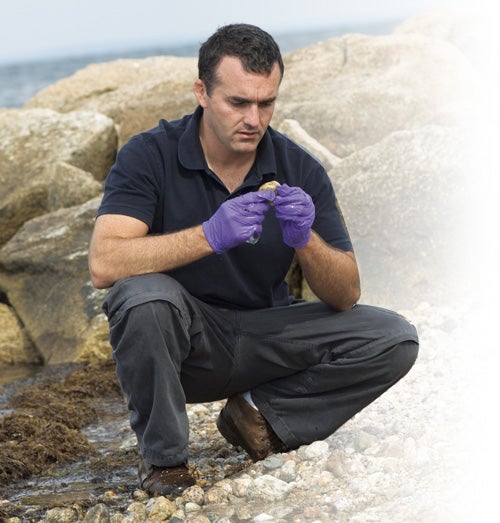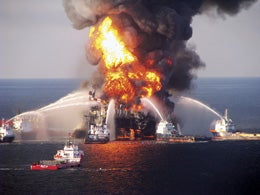Evaluating Deepwater

Irony runs all over Christopher Reddy’s story. As an undergraduate at Rhode Island College, the Cranston, R.I., native seemed the least likely candidate to become a senior scientist at the prestigious Woods Hole Oceanographic Institution, where he has worked since 1997.
Being a scientist can be a treasure because “you can seize opportunities, explore new fields, and be nimble in your interests. And because of that, my experiences have taught me how much, thankfully, I still have to learn about oil spills and being a scientist.””
His classmates at RIC certainly wouldn’t have expected him to earn a Ph.D. in chemical oceanography nor would they imagine him writing nationally published articles about last year’s monumental Deepwater Horizon oil spill in the Gulf of Mexico.
In fact, Reddy, who earned his Ph.D. in 1997 from URI’s Graduate School of Oceanography, was the first scientist to have a paper published on the Deepwater spill. Last summer the prestigious journal Science included the results of his team’s study of underwater plumes containing petroleum hydrocarbons at the Deepwater site, which showed for the first time that oil leaking from an undersea source doesn’t always rise to the surface.
On the day of the oil rig explosion in April 2010, it just happened that reporters were interviewing Reddy about research that he and his team of scientists had conducted off the coast of California. As soon as news of the explosion reached them, the journalists peppered him with questions about impending disaster in the Gulf of Mexico. Not long after, Reddy and an international team of scientists received a grant from the National Science Foundation to conduct oil plume research using a submersible vehicle operated from onboard URI’s research vessel Endeavor.

“It was an amazingly fast process,” Reddy said of the research done in June 2010. “The article relating results of the research appeared in Science in August. It all happened really quickly.”
Reddy and his team tracked an oil plume 3,500 feet below the surface of the Gulf. The plume extended for at least 20 miles, was a mile wide, and 600 feet deep. While Reddy acknowledges that their findings are significant and have broken new ground in understanding how underwater oil spills behave, it is way too early to assess the damage done to the environment and marine life and to determine how much oil was spilled and where it all went.
As a result of his work and past experiences studying numerous other oil spills, Reddy testified twice before Congress on aspects of the oil spill. He also has written half-a-dozen op-ed columns for publications across the country and gave a public lecture in URI’s Edwards Auditorium as part of the GSO’s annual Vetlesen Lecture Series. His messages are clear: Don’t jump the gun on assessing, or even expecting assessments of, damage done by the spill because that will take years; focus instead on preparations for similar incidents while reforming laws and regulations to prevent future spills.
“Spectacular science has been done in respect to the Deepwater Horizon spill,” Reddy says. “An extraordinary number of samples have been taken and an amazing amount of data has yet to be produced by a wide range of scientists. It will all be valuable in the future, but it will take time for it all to come out and be digested.”
Reddy ended up at the GSO after a fits-and-starts undergraduate career in chemistry: “I wasn’t the most serious student when I started; I did better later.” He credits Professor Emeritus James Quinn with being the engine that drove him into marine chemistry. “I barely got into the GSO,” Reddy says. “I didn’t have the best grades, but my GRE scores were fair. I actually applied for the Ph.D. program because I had been working at chemical firms nearby, but GSO said no. Instead, I was accepted as a master’s student (with concern) and worked second shift as a chemist during my first year. After the first year they reevaluated me and gave me the okay.
“Jim Quinn was the key; he looked out for me and stuck up for me. He was one of the finest professors at URI ever. Students always came first with him—he considers himself successful if his students succeed. There are scientists working all over the world who were trained by Jim Quinn.”
In a column he wrote for The Chronicle of Higher Education last October, Reddy confessed that prior to his work on the Gulf oil spill he was feeling distressed by an inability to make a true impact in the regulatory world through his research and the new techniques he had developed for measuring compounds in ocean waters. He was looking for something new, but then the Gulf spill occurred and the “Jim Quinn engine” revved up again. Writing about the Gulf research, Reddy said, “the crew and science team worked around the clock collecting hundreds of samples. It was clear we were making new discoveries, and spirits were high.”
The disappointment he had been feeling about his work disappeared. In The Chronicle article he noted that being a scientist can be “a treasure” because “you can seize opportunities, explore new fields, and be nimble in your interests. And because of that, my experiences have taught me how much, thankfully, I still have to learn about oil spills and being a scientist.”
Reddy notes that much work remains to be done on the Gulf oil spill, but the most important work relates to prevention and preparedness. Despite BP’s poor safety record— including a fatal explosion at a Texas refinery, a severe oil spill in Prudhoe Bay, and accusations of dangerous cost-cutting and neglect of equipment maintenance—Reddy thinks both the company and the U.S. government did a good job responding to the spill and getting oil out of the area; however, he remarked, “you can still learn a lot from what went wrong or what didn’t work.”
And major questions remain: For instance, why didn’t the oil that formed the plume come to the surface? “It’s a basic scientific question,” Reddy says. “Assessing all the aspects of what happened in the Gulf will take years. It’s not like CSI on television; there’s no 100 percent certainty. It takes time, teamwork, and patience. It took five years to evaluate the effects of 11-million gallons in the Exxon Valdez spill. It will take at least that long to evaluate this spill.”
By John Pantalone ’71
 Home
Home Browse
Browse Close
Close Events
Events Maps
Maps Email
Email Brightspace
Brightspace eCampus
eCampus


